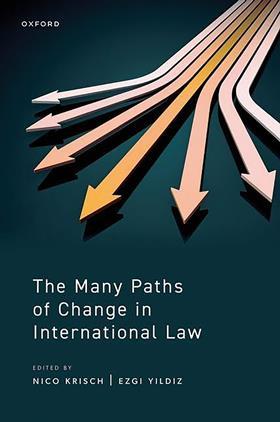Actors on a global stage
The Many Paths of Change in International Law
Edited by Nico Krisch & Ezgi Yildiz
£110, Oxford University Press
★★★★✩
International law appears to be ‘having a moment’. The news is filled with refugee crises, the war in Ukraine, the UK Rwanda Safety Bill and the decision of the International Court of Justice on the actions of Israel in Gaza. The post-war consensus developed a rules-based international system which is underpinned by a network of international organisations known by their many initialisms: UN, UNHCR, WTO, TPP, ICJ, ICC, ECHR and so on. But how can such a system, created to avoid a repeat of the totalitarianism and war of the 1940s, adapt to deal with the global challenges of the 2020s? The Many Paths of Change in International Law, a collection of essays by international lawyers and political scientists, seeks a better understanding of the ways in which international law changes.

Formal structural change happens when states make treaties. But treaties are relatively rare and difficult to conclude. This book examines gradual or informal change brought about by other drivers. The authors distinguish between informal change and informal law-making – ‘the latter leads to the creation of new rules while the former means changes in the interpretation and understanding of existing rules’. Informal change can be brought about by the simple act of codifying existing norms or the publication of a handbook such as the UNHCR Handbook on Procedures and Criteria for Determining Refugee Status which, we are told, has influenced the interpretation and understanding of the term ‘well-founded fear of being persecuted’.
Unsurprisingly, powerful actors have been most successful in bringing about informal change. Change can be initiated by a hostile response from leaders of powerful states to particular international law rules, practices or institutions. The reaction of president Trump to World Trade Organization rules, in particular the dispute settlement provisions, led to changes in practice. Smaller states and actors can be agents of change through collectively canvassing and pushing for change. Judges can also bring about informal change in international law through advancing particular interpretations of existing norms and practices. Civil society movements have been able to seize the initiative and seek ‘change from below’ in the field of climate law.
But change is not always positive. We are told that the 1951 UN Refugee Convention has, without any formal amendment, seen the creation of a ‘non-entreé regime’ in the Global North. Also, given that the community of practitioners in the international legal arena is dominated by mainstream scholars from the Global North, the authors submit that ‘the bureaucratic pathway is likely to support informal change favoured by dominant actors’. And a hostile response of a powerful actor can create an environment in which other states attempt to take advantage of a perceived weakness in the international legal order.
This book is a stimulating volume which should be read by policy experts and anyone wanting to understand change and its consequences in international law.
Kevin McVeigh is a partner at Elliott Duffy Garrett Solicitors, Belfast
The Many Paths of Change in International Law
★★★★✩
With such an ambitious publication, it is not possible to communicate the nuance of the varying viewpoints. The central thesis is that major changes to international law (via treaties) are few and far between; instead, evolution is through ‘reinterpretation’. Interpretation depends on perspective, providing the editors’ four themes: strategy (ways of effecting change); form (the substance of international law); forces (of change, including the impact of environmental change); and situating (contextualisation).
A recurring theme – and a personal interest – is international coordination (or the lack of it) around the response to climate events. The chapter by Jaye Ellis, associate professor at McGill University, is devoted to this issue.
Ellis suggests that data-driven sustainability initiatives (such as emissions reporting and the Science Based Targets approach) have added currency because of a failure of pre-existing international legal norms to effect change. The point is not to denigrate the contribution of data as a benchmarking tool for measuring performance, but to query whether bureaucracy is now leading the way – the tail wagging the dog.
The argument that international law has been found wanting in creating change, and that separate standards – particularly the use of data – have emerged as a symptom of that failure, is well made. The adoption of the Sustainability Development Goals in 2015 and the Paris Agreement, the treaty to manage temperature increase relative to pre-industrial levels, has not translated into outcomes. Overlapping rules and regulations between jurisdictions remain difficult to navigate even for the initiated, despite international efforts at convergence.
Observers may disagree with the problematisation of data but, in any event, all is not lost. The power of international law comes from its ability to change, not just to provide rules but a framework within which constructionist approaches flourish. Indeed, Ellis gives the example of the quinquennial ‘stock take’ built into Article 14 of the Paris Agreement, drafted such that international cooperation and collaboration is anticipated and becomes central to development. It is in this cooperation that a role for international law re-emerges, playing to its strengths of ‘flexibility and adaptability, oriented around a problem-solving approach’.
Overall, this book contains deep thinking about the nature of international law and the drivers behind it while wrestling with its ‘real world’ impact.
Tom Proverbs-Garbett is a consultant































No comments yet